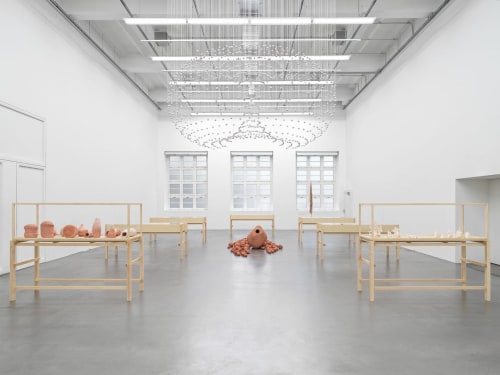
In 2023, the Zurich Art Prize, awarded annually by Museum Haus Konstruktiv and Zurich Insurance Company Ltd, goes to Damián Ortega (b. 1967 in Mexico City, where he lives and works). This artist is the 16th winner of the renowned award.
At Museum Haus Konstruktiv, Ortega is presenting two installations under the exhibition title Essay on Exchange. They differ radically from one another in terms of materiality and conception, but do have subtle thematic commonalities. The focus of the show is on the large installation on the first floor. Here, ten carefully prepared display cases are arranged in the space in such a way that (from a bird’s-eye view) they resemble numbers on a clock. They are supplemented by two multipart sculptures, one placed on the floor and the other hanging from the ceiling. Both the sculptural works and the objects positioned in the display cases (there are thousands of them) are made by hand from clay, most of which comes from the Mexican state of Oaxaca: a region with a long tradition of pottery production. Ortega began working with this naturally occurring material several years ago. For his Zurich Art Prize exhibition, he has tried to approach it in a completely open-minded way, by engaging in a ‘graphic’ process with no predetermined outcome: Starting with the simple operation of shaping a small lump of clay into a handheld ball, the concept for the formal design and technical processing of the material gradually emerged from his experiences when handling it. “The pieces appeared throughout a period of experimentation and intuitive play,” explains Ortega, “in which the ceramic began to form its own concepts and links as it was modeled and fired in different facets – from raw material to high-temperature firing.” In the exhibition space, this conceptual and material process of maturation is visualized, in that the objects are presented primarily in the order of their creation – clockwise.
Essay on Exchange adeptly plays with notions related to the imparting of historical knowledge. The setting, as we know it from cultural history museums in Europe (the presentation behind glass, the categorization into groups of objects, the codification by means of titles and subtitles) conveys a certain degree of authoritativeness and gives the objects the status of historical artifacts. This status turns out to be extremely precarious though, insofar as the objects were created only recently and from one material, so they are always artworks and material studies as well. Instead of a linear narrative and verified information, the observer is thus confronted with a markedly speculative and associative history of bartering or exchange, which makes it possible to experience abstract processes of value creation in everyday life and in art, and gives rise to an interesting temporal overlap between cultural history and contemporary art.
Meanwhile, an equally speculative interweaving of the present and the near future plays out in the piece Acrylic Ocean (2023) on the second floor of the museum, where palpable clay gives way to ephemeral video images. Two textile screens each have a 25-minute sequence projected onto them, in which plastic bags, drink bottles, rubber tires and other discarded everyday objects move about in water like jellyfish, rays, sea snakes or other marine life. In front of filmed underwater scenes, the shots of the jettisoned inorganic materials blur the distinction between what is natural and what is artificial. Accompanied musically by dulcet tones, an oppressive and simultaneously enticing image emerges: It shows the potential process of nature and industry interconnecting under the sea’s surface in new ways, previously unknown to us. In other words, the residues of the exchange dynamics emerge as a new form of life, and now come to light as an epilogue to Ortega’s Essay on Exchange.